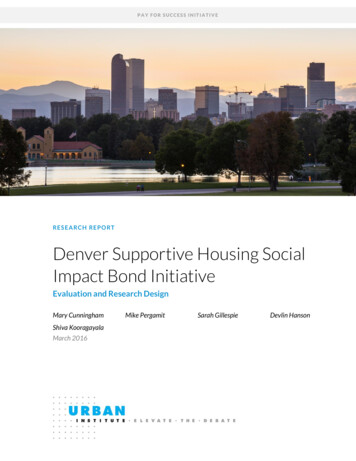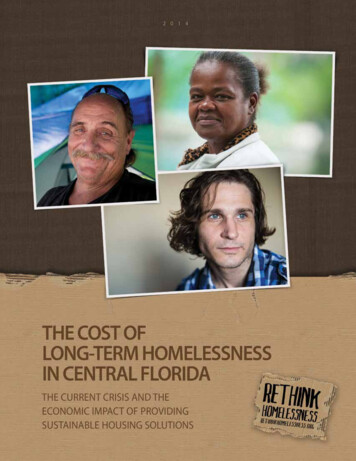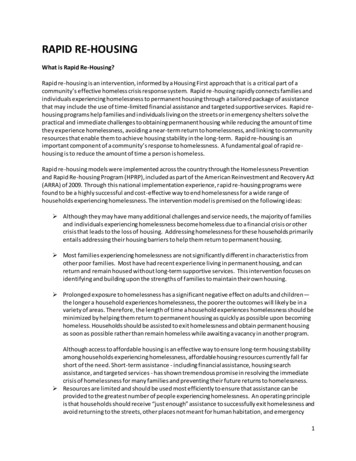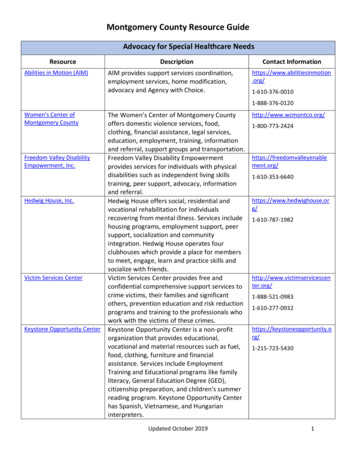
Transcription
PAY FOR SUCCESS INITIATIVERESEA RC H RE PORTDenver Supportive Housing SocialImpact Bond InitiativeEvaluation and Research DesignMary CunninghamShiva KooragayalaMarch 2016Mike PergamitSarah GillespieDevlin Hanson
ABOU T THE U RBA N INS TITU TEThe nonprofit Urban Institute is dedicated to elevating the debate on social and economic policy. For nearly fivedecades, Urban scholars have conducted research and offered evidence-based solutions that improve lives andstrengthen communities across a rapidly urbanizing world. Their objective research helps expand opportunities forall, reduce hardship among the most vulnerable, and strengthen the effectiveness of the public sector.Copyright March 2016. Urban Institute. Permission is granted for reproduction of this file, with attribution to theUrban Institute. Cover image via Shutterstock.
ContentsAcknowledgmentsvDenver Supportive Housing Social Impact Bond Initiative1Background and Context1Program Structure2Target Population2Housing Types3Program Services4Usual Care5Overview of Evaluation5Theory of Change5Research Questions7Major Components of the Evaluation7RCT Design8Referral and Randomization Strategy9Data Sharing and Consent14Evaluation Components15Outcomes and Impact Study19Data Security and Ownership31Data Security31Data Ownership31Reports and Findings32Destruction of Data32Project Monitoring and Outcome Reports34Project Monitoring34Outcome Reports34Appendix A. Biweekly Engagement Dashboard36Appendix B. Monthly Pipeline Dashboard37Appendix C. Quarterly Housing Stability Outcomes Report38Appendix D. Early Analysis Checkpoint and Final Windup Jail Days Outcomes Report39Appendix E. SIB Housing Screen40Appendix F. Chronic Homelessness Screen43
Note46References47About the Authors48Statement of Independence50
AcknowledgmentsThis report was funded by the City of Denver, CSH, and the Laura and John Arnold Foundation. We aregrateful to them and to all our funders, who make it possible for Urban to advance its mission.The views expressed are those of the authors and should not be attributed to the Urban Institute,its trustees, or its funders. Funders do not determine research findings or the insights andrecommendations of Urban experts. Further information on the Urban Institute’s funding principles isavailable at www.urban.org/support.VACKNOWLEDGMENTS
Denver Supportive Housing SocialImpact Bond InitiativeBackground and ContextThe Denver Supportive Housing Social Impact Bond (SH-SIB) Initiative will provide supportive housingfor individuals who are frequent users of both criminal justice and emergency medical services in thecity of Denver, Colorado. In addition to experiencing homelessness and struggling with substance useand mental health problems, the target population commits frequent low-level offenses such as publicnuisance violations, alcohol and drug use, panhandling, and trespassing. As a result, individuals in thispopulation are frequently arrested and cycle in and out of jail, detox, and emergency services,effectively increasing costs across systems. Because they often do not receive follow-up services whenthey are released from jail, this population returns to the same risks and falls into a recurring cycle ofnegative outcomes. This cycle continuously results in high costs across city agencies and serviceproviders.The SH-SIB initiative will provide supportive housing to interrupt the status quo. Supportivehousing is an evidence-based intervention that provides housing plus intensive case management andconnects clients with community services, including primary health care (National Alliance to EndHomelessness 2007).1 Past research indicates that the joint provision of housing and services increaseshousing stability, improves mental and physical health, and decreases the number of low-level offenses.Together, those improvements lead to several desired outcomes for the city–decreases in the numberof arrests, detox visits, and use of emergency medical services (Aidala et al. 2014; Larimer et al. 2009).Overwhelming evidence shows (1) that supportive housing is effective for chronically homeless adultswho are frequent and costly users of public systems, and (2) that the cost of the program can be offsetby its benefits (Culhane, Metraux, and Hadley 2002; Perlman and Parvensky 2006).The city of Denver has identified “front-end” or frequent users who drive up the cost of publicservices, it has highlighted some of the gaps in service delivery for that population, and has identified anevidence-based solution—namely, supportive housing—to fill those gaps. Denver’s SH-SIB initiative alsogives researchers and other municipalities opportunities to understand how to efficiently targetsupportive housing to those users, to measure impacts, and to weigh the costs and benefits of the
program. The Denver SH-SIB will be one of the first supportive housing programs funded through asocial impact bond financing mechanism. The program’s structure, the investors the program attracts,the key performance measures for payment structures and thresholds, and the associated developmentof data tracking mechanisms will all contribute knowledge to the field and could lead to an expansion ofsupportive housing that uses this financing mechanism.The SH-SIB initiative includes the following core partners (table 1).TABLE 1Initiative Partners for SIB ImplementationRolePartnerLocal governmentCity of DenverPFS (Pay for Success)lendersTo be determinedIntermediaryDenver PFS LLC (jointly owned by CSHand Enterprise Community Partners)Supportive HousingProvidersColorado Coalition for the HomelessMental Health Center of DenverEvaluationUrban Institute with local partners:the Evaluation Center at the Universityof Colorado Denver and the BurnesInstituteResponsibilitiesRepay investors if performancebenchmarks are metProvide capital to fund servicesReceive principal and interest whenperformance benchmarks are metManage service providers and facilitate PFSlender agreements and payments from thecity to PFS lendersProvide housing through new tax creditsand existing vouchersProvide supportive housing servicesEstablish research designVerify that performance benchmarks aremetMeasure other outcomes of interestProgram StructureTarget PopulationThe city’s target population for the SH-SIB initiative includes frequent users of public services whoincrease the costs of such services by cycling in and out of jail and detox centers and by using emergencymedical services. Eligibility criteria for the program must result in a group of such individuals that islarge enough to fill the available housing units and to make up a separate control group. To establish atarget group, the team used arrest data from 2012 through 2014 to identify individuals who had at leasteight arrests over three years and who identified as transient (having no address or providing theaddress of a shelter) at the time of their arrest. The result was a sample size of approximately 1,456DENVER SUPPORTIVE HOUSING SOCIAL IMPACT BOND INITIATIVE2
individuals. Table 2 shows the target population’s use of public services during the three-year period forhomelessness, jail stays, and detox and other health services.TABLE 2System Use among Target Population with Eight or More Arrests over Three YearsPublic serviceUseHMIS Shelter staysAt least one stay in shelters over three yearsTwo or more recorded stays over three years62 percent33 percentJail daysFirst year after eligibilitySecond year after eligibility77 jail days45 jail daysDetoxPer year after eligibility3–8 detox visitsThe data match to the Homeless Management Information System (HMIS) shows that 899 out ofthe 1,456 individuals had at least one shelter stay recorded in the HMIS over three years, and about athird had two or more recorded stays. Although we know that this population is also likely to experiencetypes of homelessness not captured in HMIS data, the data confirm that our targeting criteria willindeed reach a homeless population. Similarly, data from a random sample of the target populationshow that individuals spent, on average, 77 days in jail in the year following their eligibility and anaverage of 45 days in jail in the second year following their eligibility. The target population alsoaveraged three to eight detox visits per year over the three years following their eligibility (a range isused because of an incomplete data match for this system).Housing TypesTo meet its goal of providing 250 individuals with supportive housing units, the city will provide acombination of housing options. The units will include single-site homes in two new buildings built withlow-income housing tax credits and also scatter-site units. The latter are existing rental housing units inthe community that will be paired with a housing subsidy and services to convert them to supportivehousing. The subsidies will come from the Colorado Division of Housing, the Denver Housing Authority,flexible subsidy dollars from the SIB transaction, and the Denver Continuum of Care. Housing isexpected to become available according to the timeline in figure 1.3DENVER SUPPORTIVE HOUSING SOCIAL IMPACT BOND INITIATIVE
FIGURE 1Housing Flow TimelineFeb–Mar 2016 CCH Colorado Station 25 units totalApril–Nov 2016 Scattered-site units identified by CCH 40 units totalMar–July 2017 MHCD, 60 units CCH, 100 units 160 units totalMay–Sept 2017 Scattered-site units identified by MHCD 25 units totalNote: CCH Colorado Coalition for the Homeless; MHCD Mental Health Center of Denver.Program ServicesSupportive services such as case management will be provided by the Colorado Coalition for theHomeless (CCH) and the Mental Health Center of Denver (MHCD). Both organizations use modifiedmodels based on an assertive community treatment (ACT) model for supportive services, which is ahighly integrated and intensive approach for delivering community mental health services. Otherprograms have demonstrated that variations on the ACT model can be implemented with great success.The SH-SIB initiative’s partners (shown in table 1) will define the adaptation of ACT used for theinitiative. In addition to receiving case management services, the target population will be enrolled inMedicaid through Colorado Access, the current managed-care network in Colorado.DENVER SUPPORTIVE HOUSING SOCIAL IMPACT BOND INITIATIVE4
Usual CareWhen frequent users exit the multiple systems in which they are involved without receiving follow-upservices, they return to the same risks and behaviors and experience a recurring cycle of negativeoutcomes, adding to the high system costs. Figure 2 depicts the cycle of usual care for this population.FIGURE 2Status Quo: Cycle of Target Population Outcomes and CostsTarget Population Risks and BehaviorsCriminal offensesChronically homelessPublic nuisanceAlcohol and drugusePanhandlingTrespassingSleeping outsideIn shelterTarget Population Negative OutcomesArrestsHousing instabilityPhysical and mentalhealth challengesTarget Population Systems CostsCourt and jail daysDetox visitsEmergency medicalservicesOverview of EvaluationTheory of ChangeThe SH-SIB initiative provides supportive housing to a target population to break the cycle of jail, detox,and emergency medical services experienced by many front-end users. Supportive housing willintegrate the services of multiple systems to provide care that results in increased housing stability andimproved physical and mental health as well as fewer arrests. Along with supportive services, theintervention will provide a housing unit that is safe, sustainable, functional, and suitable for tenant5DENVER SUPPORTIVE HOUSING SOCIAL IMPACT BOND INITIATIVE
stability. An important difference between supportive housing and other models is its “housing first”tenet, not sobriety first.The theory of change behind supportive housing is that once individuals in the target population arehoused, they are not living on the streets, openly drinking in public spaces, panhandling, trespassing, orengaging in similar sorts of nuisances or crimes. Instead, they have a place to live and sleep. They maycontinue with substance use, though research shows modest reductions in substance use over time(Collins 2011).As depicted in figure 3, the intermediate outcomes of this intervention include increased housingstability; reductions in homelessness, drug and alcohol use, and instances of public nuisance; andimprovements in mental and physical health. These intermediate outcomes will result in severalintended program outcomes, including decreases in arrests, jail days, detox visits, and the use of emergency medical services. These ultimate outcomes are of particular interest to investors and to the city.Figure 3Theory of How Supportive Housing Leads to a Reduction in Front-End User CostsGoal: To reduce jail days, detox visits, and use of emergency medical servicesTarget population: Chronically homeless, frequent users of jail, detox, and emergency medical servicesProviders:Mental Health Center of Denver (MHCD)Entry points:Police contactColorado Coalition for the Homeless (CCH)Noncustodial arrestCustodial arrestSupportive housing seeks to integrate the services of multiple systems to provide care that results in increases inhousing stability and physical and mental health and decreases in arrests.Intervention—supportive housingHousing subsidy Provide rent assistance in ahousing unit that is safe,sustainable, functional, andconducive to tenant stabilityCase management services Develop a case plan Facilitate access to benefits Provide referrals Coordinate careHealth care services Enroll in Medicaid Provide mental and physicalhealth careIntermediate outcomesLong-term outcomesIncrease housing stability Reduce homelessness Provide a safe, healthy, stablehousing unitDecrease public nuisance Decrease alcohol and drug use,trespassing, and panhandlingImprove health Improve mental health Improve physical healthDecrease arrestsDecrease jail daysDecrease detox visitsDecrease use of emergency medicalservicesDENVER SUPPORTIVE HOUSING SOCIAL IMPACT BOND INITIATIVE6
Research QuestionsTwo sets of research questions drive the evaluation of the Denver SH-SIB. The questions will beanswered through two primary components of the evaluation, including a process study and anoutcomes and impact study.1.Questions in the process study include the following: How is the program implemented? Howare eligible individuals located and engaged? How do participants take up housing and services?Does it align with the CSH guidebook, “Dimensions of Quality Supportive Housing”? Is therefidelity to the service model? How does this look different from usual care? What types ofsystems change and services integration were achieved? What are the key facilitators andchallenges?2.The following are questions for the outcomes and impact study: Do housed participants retainhousing? Does supportive housing increase housing stability and decrease the use of high-costpublic services (e.g., jails, courts, detox, homeless shelters, and hospitals)? Do outcomes differfor participants housed in scatter-site housing versus single-site housing? Were performancegoals met so that investors should be paid?Major Components of the EvaluationPROCESS STUDYKey process-related information, including the housing and referral pipeline, is necessary to manageimplementation and to make midcourse corrections to keep the initiative on track to achieve long-termoutcomes. Process information will also help us interpret the results of the impact evaluation based ondocumentation of the program model and participant engagement. To collect information about thesedifferent domains, we will manage an engagement dashboard as well as a housing enrollment pipeline.We will conduct annual site visits and informant interviews with service providers and other importantstakeholders. We will also review program-related documents such as training manuals, standardoperating procedures, or other descriptions of program components.OUTCOMES AND IMPACT STUDYTo validate the data needed to support interim investor payments, which will be based on housingretention among housed participants, we will (1) track participant exits from housing and measure daysspent in housing; (2) validate the data needed to support final investor payments, which will be based on7DENVER SUPPORTIVE HOUSING SOCIAL IMPACT BOND INITIATIVE
the impact that supportive housing has on the target population’s jail days; and (3)explore impacts on abroader set of outcomes and consider whether those outcomes differ for participants housed in scattersite versus single-site units. As described in the next section, we will use a randomized controlled trial(RCT) as part of the research design. Eligible individuals will be randomly assigned to one of twogroups—one that receives supportive housing as part of the initiative or one that receives usual careservices. We will measure differences in key system outcomes between the groups (i.e., their use ofservices) using administrative data from the primary systems of interest, such as jails, courts, detoxunits, homeless shelters, and hospitals.TABLE 3Primary Evaluation ComponentsEvaluationcomponentResearch questionsData sourcesProcess studyHow is the program implemented? How are eligibleindividuals located and engaged? How do participantstake up housing and services? Does it align with the CSHguidebook, “Dimensions of Quality Supportive Housing”?Is there fidelity to the service model? How does this lookdifferent from usual care? What types of systems changeand services integration were achieved? What are the keyfacilitators and challenges?Engagement dashboard,housing enrollmentpipeline, annual sitevisits and key informantinterviews, review ofprogram-relateddocumentsOutcomes and impactstudyDo housed participants retain housing? Does supportivehousing increase housing stability and decrease the use ofhigh-cost public services (e.g., jails, courts, detox,homeless shelters, and hospitals)? Do outcomes differ forparticipants housed in scatter-site housing versus singlesite housing? Were performance goals met so thatinvestors should be paid?Program housingretention data,administrative data fromsystems of interestRCT DesignRandomized controlled trials are widely considered to be the gold standard in measuring theeffectiveness of a policy or intervention. RCTs are useful for establishing the counterfactual, or whatwould have occurred in the absence of the intervention. In the case of this initiative, the RCT design willbe able to compare the trajectories of front-end users who receive priority placement in supportivehousing and those who receive usual care. The target population for the Denver SH-SIB initiativeincludes many more individuals who are in need of and are eligible for the intervention than can beaccommodated by the city’s limited housing slots. The initiative will therefore allocate the limitedhousing slots by lottery, which is a fair way to allocate the scarce housing resources, and it also enablesrandom assignment.DENVER SUPPORTIVE HOUSING SOCIAL IMPACT BOND INITIATIVE8
The evaluation will track outcomes for both the supportive housing and the usual care groups andattribute any differences to the supportive housing intervention. The selected eligibility criteria willallow for a sample of at least 500 participants, including 250 in the treatment group and 250 in thecontrol group. This sample size allows the evaluation to detect effects of at least 25 percent, which theliterature suggests is reasonable to expect for reduced jail time (Aidala et al. 2014). For example, if thecontrol group experiences an average of 50 days in jail, we can attribute effects to the program if thetreatment group experiences 25 percent fewer days, or an average of 37.5 days in jail.Referral and Randomization StrategyUsing the eligibility criteria, the Denver Police Department (DPD) will identify eligible individualsthrough a data pull and create a deduplicated, deidentified eligibility list for the initiative, assigning aunique research ID to each individual on the eligibility list (see figure 4). Program enrollment beginswhen individuals are identified from the eligibility list as they enter a designated intake point. Intakepoints include police contact and arrest, both custodial and noncustodial arrests. DPD will serve as acoordinated intake point and will electronically maintain the SIB eligibility list (including periodicupdates) and match the eligibility list with daily arrest and contact lists to identify eligible individuals.DPD will then send a deidentified list of matched SIB-eligible individuals to the Urban Institute staffmembers, who will ensure that eligible individuals are randomly assigned only once and who will stratifyarrest and police contact intakes equally.The Urban Institute will generate a deidentified list of individuals assigned to the treatment groupand send it to the referral coordinator at the Denver Crime Prevention and Control Commission(CPCC). The CPCC referral coordinator will link the unique research IDs back to the individualidentifiers (i.e., names and as much information as is available from the intake points to support locationand outreach) on the master eligibility list. The coordinator will then send those individuals’ informationto the service providers that have available housing slots. If necessary, staff within DPD will help withlocating eligible individuals and connecting them with service providers.9DENVER SUPPORTIVE HOUSING SOCIAL IMPACT BOND INITIATIVE
FIGURE 4Referral and Randomization FlowchartDaily arrest record (custodialand noncustodial)Daily police contactDPD: Daily match to SIB eligibility list and check for transiency flag in system at time of intake; send deidentified, matched list to Urban Referral Coordinator with research IDsUrban referral coordinator Based on housing availability and pipeline flow, randomizes select number ofeligible individuals using research ID Sends research IDs of only individuals assigned to treatment group to CPCCReferral Coordinator Removes randomized individuals from eligibility list and manages updates tolist as needed with DPDCCH and MHCD—communicateavailable housingslotsCPCC referral coordinator Links research IDs to identifiers on master eligibility list Sends names to CCH/MHCD and co-responders including as muchinformation on location and situation as possibleCCH and MHCD SIB team Names will go to team with available units When both have units, teams will coordinate based onexisting client relationshipsControl groupReceivescommunityservices as usualCo-responders Assist in locatingtreatment individualsTreatment group Contacted by CCH/MHCD or co-responders within 24hours of randomization (Release of Information) Assertively engaged for a minimum of 3 months Must pass SIB housing screen to proceed When ready and willing, offered housing slot based onrandomization dateEngagement dashboard—to track contacts and reasons forattritionUnhoused—still intreatment and eligiblethroughout SIBHoused—and matched withservice teamPlannedexitUnplannedexitNote: CCH Colorado Coalition for the Homeless; CPCC Crime Prevention and Control Commission; DPD Denver PoliceDepartment; MHCD Mental Health Center of Denver; SIB Social Impact Bond.DENVER SUPPORTIVE HOUSING SOCIAL IMPACT BOND INITIATIVE10
If both CCH and MHCD have supportive housing slots available, the two service providers will worktogether to assign individuals based on any existing client relationships. Outreach workers will attemptto locate each referred individual within 24 hours of referral to minimize location challenges. Whenoutreach workers locate individuals in the treatment group, they will first have them sign a Release ofInformation. They then can immediately begin program engagement, working with other serviceproviders and co-responders to engage the individual. Service providers will engage participants in thetreatment group for a minimum of three months before stepping down engagement and requesting anew referral.After they are located, individuals must also pass the SIB housing screen (appendix E) to confirmhomelessness and continue engagement toward housing placement. The SIB housing screen will screenout only individuals who are not considered homeless according to the SIB screening requirements.However, it will also screen for chronic homelessness (appendix F), which will help determine the mostappropriate housing subsidy for the individual. Urban, working with DPD, will update the list to ensurethat individuals are randomized only once, will manage any updates as the list is refreshed or expanded,and will coordinate with service providers to turn randomization on and off as necessary.Randomization StratificationBecause eligible individuals can be randomly assigned from three different intake points—policecontact, noncustodial arrest, and custodial arrest—it is important that the treatment and control groupsbe equivalent in terms of the number of individuals randomized from each intake point. To ensure thistype of equivalency, we use randomization stratification. Each day, each eligible individual from all threeintake points will be given a number generated by a random number generator from a uniformdistribution using Stata software. The sample will be stratified across the three entry types; that is, thenumber of treatment individuals in each entry type will equal the number of control individuals in thesame entry type.The treatment and control groups will be created based on their random number and the number ofindividuals in that entry type to be matched. The treatment group will be composed of the individualswith the lowest random numbers that day, up to the number of open slots, conditional upon having atleast one possible match within that individual’s entry type. The control group will be identified as thenext lowest random numbers in the entry type group.For example (shown in table 4), we might have two open housing slots to fill on a given day. We wantto randomize two individuals into treatment and two into control. We will take the two individuals withthe lowest random numbers—in this example, they would be PIN 3 and PIN 4, with 102 and 122.11DENVER SUPPORTIVE HOUSING SOCIAL IMPACT BOND INITIATIVE
However, there is no comparable control (of the same entry type) for PIN 3, so PIN 3 cannot be atreatment case. We would then pick the next lowest random number, which is 138, for PIN 1; there isanother individual in that entry type that can be a control, so PIN 1 would be a treatment case. We thenpick the controls as the next lowest random numbers within each entry type; PIN 2 for custodial arrestsis the match for PIN 1, and PIN 5 is the match for PIN 4 in the contact group. No other cases arerandomly assigned, and unassigned individuals will be eligible for a new random assignment if they comeback in through one of the entry points on another day.TABLE 4Example of Random AssignmentPINRandom number1234567138476102122180367757GroupCustodial arrestCustodial arrestNoncustodial entControlNoneTreatmentControlNoneNoneSIB HOUSING SCREENThe SIB housing screen that will be completed for each individual randomized to the treatment group isbased on the strict US Department of Housing and Urban Development (HUD) definition ofhomelessness as outlined in the federal HEARTH Act. That definition includes the following categories:the core definition (living in a shelter, on the street, or exiting an institution after previously beinghomeless); imminently losing primary nighttime residence; experiencing persistent housing instability;and fleeing domestic violence.The referral strategy will begin with using the screen to eliminate from consideration anyindividuals who do not meet the strict HUD definition of homelessness. Individuals who are screenedout will not be eligible for supportive housing at that time, but they will remain in the treatment groupand can be rescreened if their situation changes in ways that would make them eligible for supportivehousing. The screen includes additional questions that will help us understand whether participantswho are screened out would be eligible under a slightly modified definition of homelessness.If the evaluation risks screening out too many participants from the treatment group, thus creatingan equivalency problem between the treatment and control groups, then we will modify the housingscreen to reflect a modified definition of homelessness and allow the service providers to continueengaging any treatment individuals who would then be eligible. This strategy still allows the evaluationDENVER SUPPORTIVE HOUSING SOCIAL IMPACT BOND INITIATIVE12
to provide a clear description of the homelessness characteristics of the full treatment group. Theservice providers will be trained on how to use the housing screen and Urban will closely monitor thescreening process.MINIMUM TREATMENT RANDOMIZATION TIMELINEThe minimum treatment randomization timeline shown in table 5 ensures that a sufficient number ofindividuals are randomized to the treatment group to meet available housing slots. Urban will ensurethat individuals are randomized at least one month before housing slots become available to allow forengagement before lease-up. Should the lease-up schedule be amended at any time, Urban can alsoquickly amend the randomization timeline.TABLE 5Minimum Treatment Randomization TimelineMonthNovember 2015December 2015January 2016February 2016March 2016April 2016May 2016June 2016July 2016August 2016September 2016October 2016November 2016December 2016January 2017February 2017March 2017April 2017May 2017June 2017July 2017August 2017September 201713Total mentsMinimum monthlytreatmentassignmentsMinimumcumulativ
Detox Per year after eligibility 3–8 detox visits The data match to the Homeless Management Information System (HMIS) shows that 899 out of the 1,456 individuals had at least one shelter stay recorded in the HMIS over three










